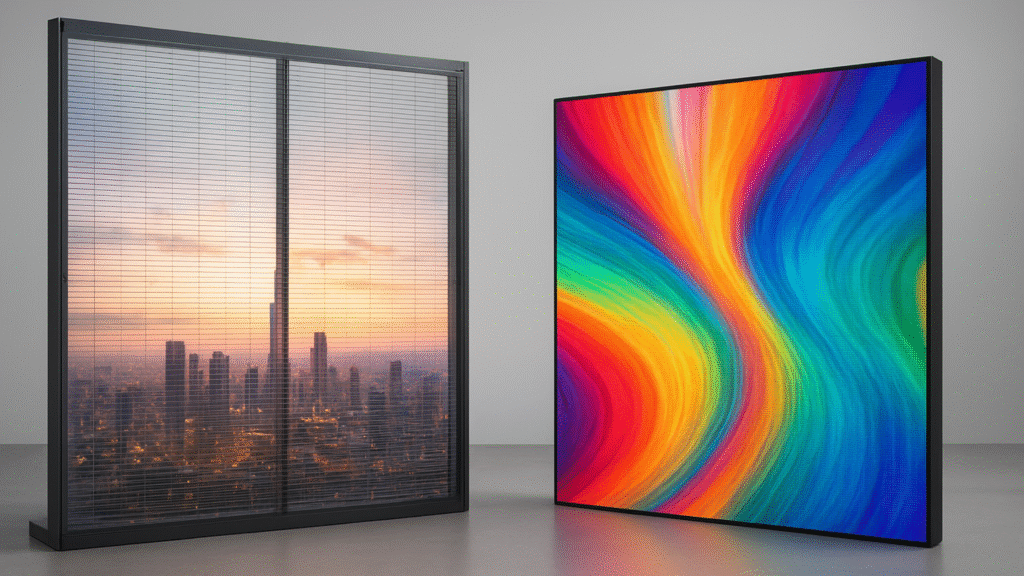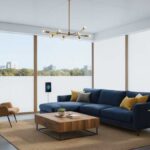In the era of modern architecture and immersive retail and office spaces, digital display technology has evolved significantly. Businesses and designers now seek solutions that combine functionality, aesthetics, and flexibility. Among the most popular innovations are transparent LED glass and traditional LED screens, both of which serve as dynamic display mediums but differ in design, application, and impact.
Companies like Glasstronn are leading the way in helping businesses integrate these technologies, providing tailored solutions for retail, corporate, and hospitality projects. By understanding the differences between transparent LED glass and conventional LED screens, businesses can make informed decisions that optimize space, enhance engagement, and maintain a modern aesthetic. Glasstronn ensures that each solution aligns with client objectives, balancing innovation with practicality.
What is Transparent LED Glass?
Transparent LED glass is a high-tech architectural glass that incorporates LED elements within its layers, allowing it to display visuals, videos, and animations while maintaining a level of transparency. When not in use, the glass retains a clear, see-through appearance, allowing natural light to flow through and preserving visibility of the space behind it.
Key features of transparent LED glass include:
- Transparency levels ranging from 60% to 95%.
- Slim, lightweight panels suitable for wall integration.
- Brightness adjustable for indoor and outdoor conditions.
- Energy-efficient LED components.
- Customizable shapes, sizes, and configurations.
This dual functionality makes it particularly attractive for modern offices, retail stores, and luxury hotels.
What Are Traditional LED Screens?
Traditional LED screens are standalone digital displays composed of individual LED modules that form a continuous screen. They are widely used in advertising, events, and large-scale presentations due to their brightness, resolution, and visual impact.
Key features of traditional LED screens include:
- High brightness levels suitable for outdoor use.
- Ability to display full-color videos and images with high resolution.
- Flexible sizes via modular installation.
- Typically opaque, blocking visibility behind the screen.
While traditional LED screens are highly effective for broadcasting information and advertising, they lack the transparency and design integration benefits of transparent LED glass.
Key Differences Between Transparent LED Glass and Traditional LED Screens
1. Transparency & Visibility
- Transparent LED Glass: Maintains clear visibility when not displaying content, allowing spaces to remain open and bright.
- Traditional LED Screens: Completely opaque, blocking the view behind the screen.
2. Aesthetic Integration
- Transparent LED Glass: Seamlessly integrates into modern architectural designs, acting as both a functional display and a part of the building structure.
- Traditional LED Screens: Appears as a separate, standalone unit and may require additional framing or mounting.
3. Space Efficiency
- Transparent LED Glass: Can be applied to windows, partitions, or walls, serving dual purposes without consuming extra space.
- Traditional LED Screens: Requires dedicated wall or floor space, sometimes obstructing pathways or design flow.
4. Energy Efficiency
- Transparent LED Glass: Consumes less energy compared to large traditional LED screens due to fewer LED components and integrated lighting.
- Traditional LED Screens: Higher energy consumption, especially for large-scale outdoor displays.
5. Versatility in Applications
- Transparent LED Glass: Suitable for offices, retail storefronts, hotels, and exhibitions where transparency and design matter.
- Traditional LED Screens: Ideal for outdoor advertising, stadiums, events, and indoor displays where opacity is not a concern.
6. Installation Flexibility
- Transparent LED Glass: Lightweight panels allow flexible installation on glass walls, partitions, and facades.
- Traditional LED Screens: Often heavier and requires structural support, making installation more rigid.
7. Customer Engagement
- Transparent LED Glass: Provides a subtle, futuristic visual experience that engages viewers while maintaining a connection to the surrounding environment.
- Traditional LED Screens: Commands attention through brightness and scale but may feel intrusive in modern interiors.
Applications of Transparent LED Glass
Transparent LED glass is rapidly becoming the preferred choice for projects requiring innovation and aesthetic appeal. Key applications include:
1. Retail Spaces
- Storefronts display promotional content while allowing customers to see inside the store.
- Interactive experiences attract walk-in traffic and boost engagement.
2. Corporate Offices
- Conference rooms and office partitions can double as digital displays for presentations or company updates.
- Maintains an open, modern office environment while providing functional display areas.
3. Hospitality Sector
- Hotels use transparent LED glass in lobbies, restaurants, and event halls to elevate the guest experience.
- Creates luxury visuals without obstructing the architectural flow.
4. Events and Exhibitions
- Temporary installations allow organizers to showcase visuals while keeping the event space visually open.
5. Public Spaces
- Airports, metro stations, and malls use transparent LED glass for dynamic information displays without compromising openness.
Applications of Traditional LED Screens
Traditional LED screens remain indispensable in scenarios where maximum visual impact is critical:
- Outdoor advertising and billboards.
- Large-scale events and concerts.
- Stadiums and sports arenas.
- Indoor venues where space and opacity are not limitations.
While highly effective for broadcasting, they are less suitable for environments where architectural aesthetics or transparency is important.
Advantages of Transparent LED Glass Over Traditional LED Screens
| Feature | Transparent LED Glass | Traditional LED Screens |
| Transparency | Clear when inactive | Opaque |
| Space Efficiency | Dual-purpose surface | Requires dedicated space |
| Integration | Blends with architecture | Separate display |
| Energy Efficiency | Lower power consumption | Higher power consumption |
| Maintenance | Easy to clean glass surface | Module replacement often required |
| Visual Subtlety | Futuristic, subtle engagement | Bright, attention-grabbing, but intrusive |
These advantages explain why modern designers, architects, and retailers are increasingly adopting transparent LED glass.
Factors to Consider When Choosing Between Transparent LED Glass and Traditional LED Screens
- Project Type: Offices, hotels, and retail stores benefit from transparency, while outdoor billboards or large events favor traditional LED screens.
- Space Availability: Transparent LED glass maximizes existing surfaces; traditional screens require dedicated mounting.
- Budget Constraints: Transparent LED glass may have higher initial costs but offers long-term multifunctionality.
- Desired Visual Impact: If maximum brightness is required, traditional LED screens may be preferable.
- Installation and Maintenance: Transparent LED glass often requires specialized installation but lower maintenance; traditional LED screens require structural support and periodic module replacement.
Integration with Smart Technologies
Modern transparent LED glass can be combined with smart glass solutions, touch interactivity, and app-controlled displays. By partnering with the best switchable glass company in India, businesses can integrate advanced technologies that enhance user experience, energy efficiency, and functionality.
Future Trends in Display Technologies
The future of transparent LED glass and traditional LED screens includes:
- Interactive Transparent Panels: Touch-enabled glass surfaces for retail, offices, and exhibitions.
- Augmented Reality Integration: Combining digital overlays with transparent displays.
- Higher Efficiency LEDs: Improved brightness and energy savings.
- Flexible and Curved Panels: Enabling creative architectural installations.
These trends indicate that while traditional LED screens will continue to dominate in specific applications, transparent LED glass will gain momentum in spaces that require aesthetics, functionality, and innovation.
Conclusion
Transparent LED glass is redefining modern interior and architectural design by merging technology, aesthetics, and functionality. It offers a sleek, energy-efficient, and versatile alternative to traditional LED screens, particularly in offices, retail, and hospitality spaces.
By leveraging the expertise of companies like Glasstronn, businesses and designers can select and implement solutions that enhance engagement while preserving architectural elegance. With its commitment to innovation and quality, Glasstronn ensures that every project utilizing transparent LED glass sets new standards for visual appeal and functionality.
Whether choosing transparent LED glass for a corporate office, retail storefront, or public space, it represents the future of smart, interactive, and immersive environments. For those seeking expert guidance and state-of-the-art solutions, partnering with the best switchable glass company in India guarantees professional support, durability, and design excellence.





